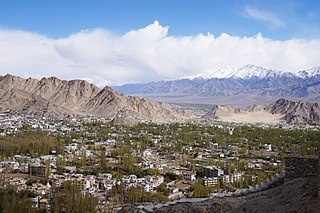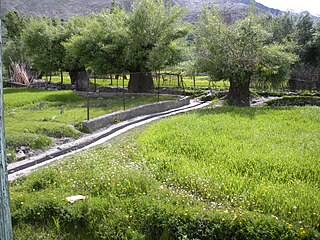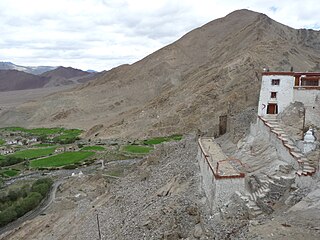
The Indian union territory of Ladakh consists of two districts. Each district elects an autonomous district council. Until 31 October 2019, these districts were part of the former state of Jammu and Kashmir.

The Indian union territory of Ladakh consists of two districts. Each district elects an autonomous district council. Until 31 October 2019, these districts were part of the former state of Jammu and Kashmir.
| District | Headquarters | Area (km2) | Population (2011 Census) | Autonomous District Council | URL |
|---|---|---|---|---|---|
| Kargil district | Kargil | 14,086 | 140,802 | Ladakh Autonomous Hill Development Council, Kargil | http://kargil.nic.in/ |
| Leh district | Leh | 45,110* | 133,487 | Ladakh Autonomous Hill Development Council, Leh | http://leh.nic.in/ |
| Total | 59,146* | 274,289 | |||
* Indicates area under the actual control of India.
Demands have been raised for the creation of new districts in Ladakh. There had been 9 proposals to make districts. local BJP unit has hinted the creation of two new districts: Nubra and Zanskar. [1] The Ladakh Buddhist Association Zanskar (LBAZ) has also been demanding the creation of Zanskar district. [2]

Ladakh is a region administered by India as a union territory and constitutes an eastern portion of the larger Kashmir region that has been the subject of a dispute between India and Pakistan since 1947 and India and China since 1959. Ladakh is bordered by the Tibet Autonomous Region to the east, the Indian state of Himachal Pradesh to the south, both the Indian-administered union territory of Jammu and Kashmir and the Pakistan-administered Gilgit-Baltistan to the west, and the southwest corner of Xinjiang across the Karakoram Pass in the far north. It extends from the Siachen Glacier in the Karakoram range to the north to the main Great Himalayas to the south. The eastern end, consisting of the uninhabited Aksai Chin plains, is claimed by the Indian Government as part of Ladakh, but has been under Chinese control.

Balti is a Tibetic language natively spoken by the ethnic Balti people in the Baltistan region of Gilgit-Baltistan, Pakistan, Nubra Valley of the Leh district and in the Kargil district of Ladakh, India. The language differs from Standard Tibetan; many sounds of Old Tibetan that were lost in Standard Tibetan are retained in the Balti language. It also has a simple pitch accent system only in multi-syllabic words while Standard Tibetan has a complex and distinct pitch system that includes tone contour. Due to effects of dominant languages in Pakistani media like Urdu, Punjabi and English and religious impact of Arabic and Persian languages, Balti, like other regional languages of Pakistan, is continuously expanding its vocabulary base with loanwords.

Kargil district is a district in Indian-administered Ladakh in the disputed Kashmir-region. It is one of the two districts comprising the Indian-administered union territory of Ladakh. The district headquarters are in the city of Kargil. The district is bounded by the Indian-administered union territory of Jammu and Kashmir to the west, the Pakistani-administered administrative territory of Gilgit–Baltistan to the north, Ladakh's Leh district to the east, and the Indian state of Himachal Pradesh to the south. Encompassing three historical regions known as Purig, Dras and Zanskar, the district lies to the northeast of the Great Himalayas and encompasses the majority of the Zanskar Range. Its population inhabits the river valleys of the Dras, Suru, Wakha Rong, and Zanskar.
The Ladakhi language is a Tibetic language spoken in the Indian union territory of Ladakh. It is the predominant language in the Buddhist-dominated district of Leh, and a minority language in the district of Kargil. Though a member of the Tibetic family, Ladakhi is not mutually intelligible with Standard Tibetan. Ladakhis and Tibetans usually communicate with each other in Hindi or English as they do not understand each other's languages clearly.

Nubra, also called Dumra, is a historical region of Ladakh, India that is currently administered as a subdivision and a tehsil in the Leh district. Its inhabited areas form a tri-armed valley cut by the Nubra and Shyok rivers. Its Tibetan name Dumra means "valley of flowers". Demands have been raised and BJP has hinted at creation of Nubra as a new district. Diskit, the headquarters of Nubra, is 120 km north of Leh, the capital of Ladakh.

Padum is the main town and the administrative centre of the Zanskar tehsil in Kargil district, Ladakh, India. Name after the Buddhist guru Padmasambhava, it was historically one of the two main capitals of the Zanskar Kingdom, the other being Zangla. It is 235 km (146 mi) via the link road from Kargil city. The new Nimmu–Padum–Darcha road connects Padum directly to Leh in the east and to Darcha in Himachal Pradesh.

Leh district is a district in Indian-administered Ladakh in the disputed Kashmir-region. Ladakh is an Indian-administered union territory. With an area of 45,110 km2, it is the second largest district in the country, second only to Kutch. It is bounded on the north by Gilgit-Baltistan's Kharmang and Ghanche districts and Xinjiang's Kashgar Prefecture and Hotan Prefecture, to which it connects via the historic Karakoram Pass. Aksai Chin and Tibet are to the east, Kargil district to the west, and Lahul and Spiti to the south. The district headquarters is in Leh. It lies between 32 and 36 degree north latitude and 75 to 80 degree east longitude.

Kargil or Kargyil is a city in Indian-administered Ladakh in the disputed Kashmir region. </ref> It is the joint capital of Ladakh, an Indian-administered union territory. It is also the headquarters of the Kargil district. It is the second-largest city in Ladakh after Leh. Kargil is located 204 kilometres (127 mi) east of Srinagar in Jammu and Kashmir, and 234 kilometres (145 mi) to the west of Leh. It is on the bank of the Suru River near its confluence with the Wakha Rong river, the latter providing the most accessible route to Leh.

Ladakh has a long history with evidence of human settlement from as back as 9000 b.c. It has been a crossroad of high Asia for thousands of years and has seen many cultures, empires and technologies born in its neighbours. As a result of these developments Ladakh has imported many traditions and culture from its neighbours and combining them all gave rise to a unique tradition and culture of its own.

Ladakh is an administrative territory of India that has been under its control since 1947. The geographical region of Ladakh union territory is the highest altitude plateau region in India, incorporating parts of the Himalayan and Karakoram mountain ranges and the upper Indus River and valley.

The Dras River, also spelt Drass River, is a river in the Kargil district in the Indian union territory of Ladakh. It originates below the Zoji La pas in the Great Himalayan range and flows northeast towards Kargil, where it joins the Suru River. The Shingo River, which flows in a parallel direction in Pakistan-administered Baltistan, also joins the Drass River. The combined river is alternatively called Suru, Drass and Shingo by various local groups.

Tourism is one of an economic contributor to the union territory of Ladakh in Northern India. The union territory is sandwiched between the Karakoram mountain range to the north and the Himalayas to the south and is situated at the height of 11,400 ft. Ladakh is composed of the Leh and Kargil districts. The region contains prominent Buddhist sites and has an ecotourism industry.

Sankoo is a town in a valley within the Kargil district of the Union Territory of Ladakh, India. This township is located approximately 42 kilometers south of Kargil city. The valley is shaped like a bowl and is fed by several large tributary streams of the Suru River, as well as the Nakpochu river.

The Brokpa, sometimes referred to as Minaro, are a small ethnic group mostly found in the union territory of Ladakh, India around the villages of Dha and Hanu. Some of the community are also located across the Line of Control in Baltistan in the villages around Ganokh. They speak an Indo-Aryan language called Brokskat. The Brokpa are mostly Vajrayana Buddhist while some are Muslim.

Nyoma is a principal village of southern Ladakh in India, the headquarters of an eponymous subdivision, tehsil, community development block and Indian Air Force Base in the Leh district. It is located on the bank of the Indus river after its 90-degree bend near Dungti east of Nyoma and before the valley narrows to a gorge near Mahe northwest of Nyoma. The Nyoma tehsil and subdivision cover all of southern Ladakh, including the Rupshu plains south of Nyoma, the Indus valley of Skakjung north of Nyoma, and the Hanle valley. Nyoma gompa, a Buddhist monastery, is located on the hill slope north of the village.

Turtuk is a village and the headquarters of an eponymous community development block in the Indian union territory of Ladakh. It is a small village sandwiched between the Karakorum Range and the Himalayas, and one of the northernmost villages of India, close to the Line of Control between India and Pakistan. Turtuk is situated in the Nubra tehsil of the Leh district, on the banks of the Shyok River. Geographically, the village is in the Baltistan region, which has been under Pakistani administration, except for five villages of the Turtuk block which are part of India. These villages form the only region in India populated by Balti people. Turtuk is known for its fruit, especially apricots.

Chorbat Valley is a section of the Shyok river valley divided between Pakistan-administered Gilgit-Baltistan and Indian-administered Ladakh. The Pakistan-administered portion is in the Khaplu tehsil of Ghanche District in Gilgit–Baltistan, and the Indian-administered portion is in the Nubra tehsil, Leh district of Ladakh. Chorbat stretches from the edge of Khaplu to the Chalunka village of Nubra.
All Ladakh Gonpa Association (ALGA) is the central organisation of the Buddhist monasteries in Ladakh, India. It aims to preserve and strengthen the monastic institutions. It was founded by the 19th Kushok Bakula Rinpoche in 1949 and he acted as its president for 41 years, from 1949 until 1991. In 1949, the first meeting of the great monasteries was held and ten monasteries took part. All Ladakh Gonpa Association was registered in 1959 and is run by a governing body consisting of fifteen lama members belonging to all four major schools of Tibetan Buddhism. There are sixteen major monastic institutions with hundreds of monks in each monastery.
Durbuk or Darbuk, is a village and the headquarters of the eponymous subdivision and block in the Leh district of Ladakh, India. It is located in the Durbuk tehsil, and falls between Chang La mountain pass and Tangste village on the way to Pangong Tso Lake.
Chering Dorjay is an Indian politician and was a member of the Bharatiya Janata Party. Dorjay was a member of the Jammu and Kashmir Legislative Council from the Assembly Kashmir (Ladakh). He was Minister for Cooperatives and Ladakh Affairs in Jammu and Kashmir till 19 June 2018.